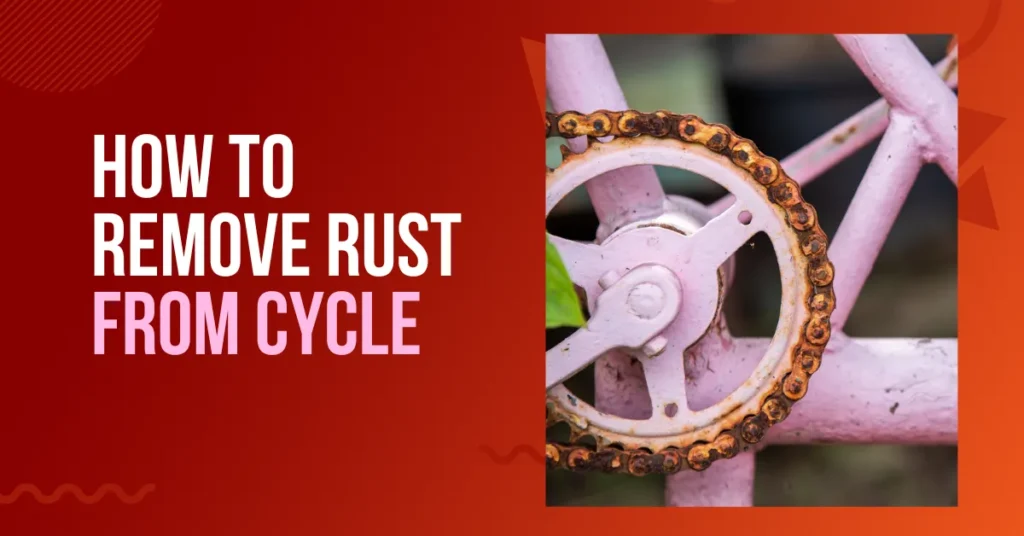
Riding a bicycle is not only a mode of transportation but also a source of joy and exercise. However, over time, bicycles are susceptible to rust, especially when exposed to moisture and the elements.
Rust not only mars the appearance of the cycle but also compromises its structural integrity. In this article, we will delve into the process of removing rust from a cycle effectively and restoring it to its former glory.
Rust and Its Impact on Cycles
What is rust?
Rust is a form of corrosion that occurs when metal reacts with oxygen and moisture, forming iron oxide. For bicycles made of steel or iron, rust can be a persistent problem, particularly in regions with high humidity or rainfall.
How does rust affect cycles?
Rust weakens the metal components of a cycle, leading to compromised strength and structural integrity. It can also hinder the smooth movements of essential parts like gears and chains, resulting in poor performance. Additionally, rust spoils the aesthetic appeal of the cycle, making it look old and neglected.
Preparing for Rust Removal
Before embarking on the rust removal process, it is crucial to take necessary safety precautions. Wear gloves and safety goggles to protect your skin and eyes from chemicals and debris. Additionally, work in a well-ventilated area to avoid inhaling harmful fumes.
See also: How to Tighten Brakes on a Bicycle
Ensure you have the following tools and materials ready for the rust removal process:
- Wire brush or steel wool
- Sandpaper of varying grits
- Rust remover solution
- Rust converter
- Primer
- Paint
Step-by-Step Guide to Removing Rust from a Cycle 🔧
Step 1: Cleaning the cycle
Begin by thoroughly cleaning the cycle to remove any dirt, grease, or grime. Use mild soap and water along with a sponge or cloth to clean all parts of the cycle.
Step 2: Removing loose rust
Use a wire brush or steel wool to gently scrub the affected areas of the cycle to remove loose rust particles. Be careful not to apply excessive force, as it may damage the underlying metal.
Step 3: Applying rust remover solution
Apply a rust remover solution to the remaining rust patches. Follow the manufacturer’s instructions and let it sit for the recommended time to dissolve the rust.
Step 4: Scrubbing and sanding
After the rust remover has done its job, use a scrubbing pad to clean the cycle further. Then, use sandpaper of varying grits to smooth out the affected areas. This step prepares the surface for the next phase of rust removal.
Step 5: Rust converter application
Apply a rust converter to the cleaned and sanded areas. The rust converter converts any residual rust into a stable compound, preventing further corrosion.
Step 6: Applying primer and paint
Once the rust converter has dried, apply a layer of primer to the entire cycle. The primer creates a suitable surface for the paint to adhere to. After the primer dries, apply a coat of paint in the color of your choice, giving your cycle a fresh look.
Preventing Rust in the Future
Prevention is always better than cure. To protect your cycle from future rusting, follow these tips:
- Store your cycle in a dry and covered area, away from rain and moisture.
- Apply a protective wax or oil coating on metal parts to create a barrier against rust.
- Regularly inspect your cycle for any signs of rust or damage and address them promptly.
Conclusion
Rust may be an inevitable consequence of time and exposure, but with the right knowledge and tools, it can be effectively removed from your cycle. By following the step-by-step guide provided in this article, you can restore your cycle’s appearance and performance, prolonging its lifespan and ensuring many more enjoyable rides.
FAQs
Can rust be removed from a cycle?
Yes, rust can be removed from a cycle with the right tools and techniques. By using rust remover solutions, scrubbing, sanding, and applying protective coatings, you can effectively get rid of rust and restore your cycle’s appearance.
Does WD-40 remove rust on bikes?
Yes, WD-40 can help remove rust from bikes to some extent. It acts as a lubricant and can loosen rust, making it easier to scrub off. However, for more stubborn rust, specific rust remover solutions are more effective.
What is the best cleaner for bike rust?
There are various rust cleaner products available in the market that work well for bike rust. Look for rust removers designed specifically for bicycles, as they are safe to use on delicate bike parts and effectively dissolve rust.
How do you restore an old rusty bike?
To restore an old rusty bike, follow these steps:
Clean the bike thoroughly to remove dirt and debris.
Use a wire brush or steel wool to scrub off loose rust.
Apply a rust remover solution to dissolve remaining rust.
Sand the affected areas to smooth out the surface.
Apply a rust converter to prevent further corrosion.
Prime and paint the bike to give it a fresh look.
Does white vinegar remove rust?
Yes, white vinegar can be used as a homemade rust remover. It contains acetic acid, which can help dissolve rust. Soak rusty parts in white vinegar for several hours or overnight, and then scrub off the rust.
What is the best homemade rust remover?
A popular homemade rust remover is a mixture of white vinegar and baking soda. Create a paste using these two ingredients, apply it to the rusted area, and let it sit for a few hours. Then, scrub off the rust with a brush or steel wool.






